| TARDIS control room | Gallery | Talk |
A TARDIS control room, also referred to as a console room, was any place on a TARDIS that contained a functioning control console. This flight deck also functioned as a point of exit. If the Doctor, the Master, the Monk and the Rani's TARDISes were any indication, control rooms were typically circular and featured relatively open floor plans, in which the control console was vaguely, but rarely precisely, in the middle of the room. Control rooms also usually contained walls with roundels, scanners for viewing the TARDIS exterior, and fairly sparse furnishings; no known TARDIS control room allowed for the operation of the console itself from a seated position.
Other than those generalisations, the shape, size and ambience of a control room, even within just the Doctor's TARDIS, was highly variable.
A control room's look could be changed over time, to suit one's tastes and personality. (AUDIO: Songs of Love [+]Matt Fitton, Doom Coalition 4 (The Eighth Doctor Adventures: Doom Coalition, Big Finish Productions, 2017).) The process by which an operator could transform a control room was fairly simple, once compared by the Fifth Doctor to changing a "desktop theme". (TV: Time Crash [+]Steven Moffat, Doctor Who Children in Need Special 2007 (BBC One, 2007).) On some occasions, a TARDIS was shown to manage the change itself. On two instances, the Doctor regenerated with extreme violence, destroying much of their control room; the TARDIS was able to completely redesign its interior and console room without the Doctor's assistance. (TV: The Eleventh Hour [+]Steven Moffat, Doctor Who series 5 (BBC One, 2010)., The Ghost Monument [+]Chris Chibnall, Doctor Who series 11 (BBC One, 2018).)
By the time of the Eleventh Doctor, his TARDIS console room had gone through at least twelve redesigns, though the TARDIS herself revealed that she had archived thirty versions. Once the control room was reconfigured, the Doctor's TARDIS archived the old design "for neatness", effectively "curating" a museum of control rooms — both those in the Doctor's personal past and future. (TV: The Doctor's Wife [+]Neil Gaiman, Doctor Who series 6 (BBC One, 2011).)
According to River Song, a TARDIS normally had multiple console rooms. (AUDIO: The Lifeboat and the Deathboat)
The Doctor's main console room
According to one account, the control room favoured by the first through seventh Doctors was in actuality intended as the secondary control room of the TARDIS, and what the Doctor called the second control room was intended as the primary control room; however, the Doctor got used to "all the white" and stopped using the primary control room, to which he only returned late in his seventh incarnation. (PROSE: The Dying Days [+]Lance Parkin, Virgin New Adventures (Virgin Books, 1997).)
However, some accounts suggested that the control rooms of the First and Twelfth Doctors were the same room, merely remodeled and redecorated. (PROSE: Twice Upon a Time)
White
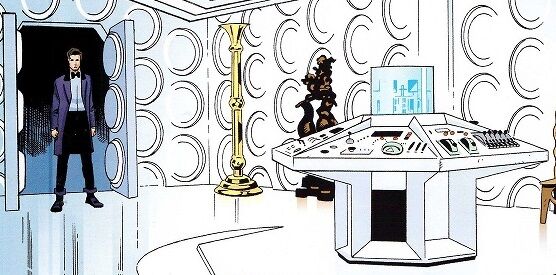
When the interior of the TARDIS used by the First Doctor was first seen by Ian Chesterton and Barbara Wright, it was a bright white room, with roundels on the walls and a large computer bank taking up a major part of the "back" wall. These computer banks contained the fault locator and various systems relating to navigational control. (TV: An Unearthly Child [+]Anthony Coburn, adapted from The Pilot Episode (Anthony Coburn), Doctor Who season 1 (BBC tv, 1963)., "The Dead Planet" [+]Part of The Daleks, Terry Nation, Doctor Who season 1 (BBC tv, 1963-1964).) One wall consisted of white hexagons with roundels implemented on them. The Doctor was known to store brandy behind one of these roundels. (TV: Twice Upon a Time [+]Steven Moffat, Doctor Who Christmas Special 2017 (BBC One, 2017).)
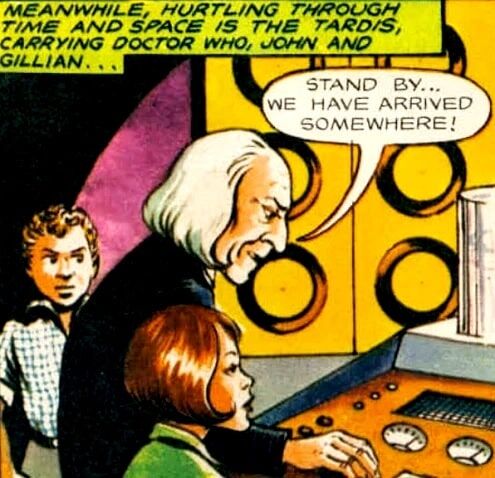
The First Doctor's TARDIS was prone to random shifts in appearance. Typically, one wall of roundels appeared flat, as if they were printed on. (TV: An Unearthly Child [+]Anthony Coburn, adapted from The Pilot Episode (Anthony Coburn), Doctor Who season 1 (BBC tv, 1963).) On another instance, a separate hexagonal wall was seen in the place of this. (TV: Twice Upon a Time [+]Steven Moffat, Doctor Who Christmas Special 2017 (BBC One, 2017).) Usually, the front doors were bulky, featuring triangular points near the hinges. (TV: An Unearthly Child [+]Anthony Coburn, adapted from The Pilot Episode (Anthony Coburn), Doctor Who season 1 (BBC tv, 1963)., et. al) This was not universal, however. On one occasion, the doors resembled that of a lift door, (COMIC: The Klepton Parasites) while on another, they were flat and simplistic with three roundels on each side. On this occasion, the doors were golden and the walls were velvet, while the console was orange. (COMIC: Prisoners of Gritog, Lua error in Module:Cite_source at line 420: attempt to index a nil value.)
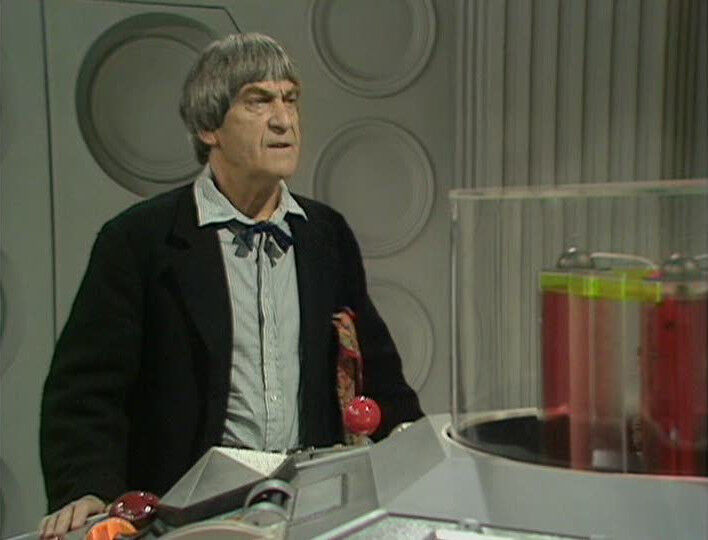
While travelling with Jamie and Victoria, the Second Doctor temporarily synchronised his TARDIS with Gallifrey by linking it to the Stattenheim remote control. It was reflected by the change in its change of appearance. (AUDIO: The Black Hole [+]Simon Guerrier, The Early Adventures (Big Finish Productions, 2015).) It looked similar to the grey interior and console later used by the Fourth Doctor but as large as the one used by the Fifth and with an additional teleport control on it. (TV: The Two Doctors [+]Robert Holmes, Doctor Who season 22 (BBC1, 1985).)
The Third Doctor's console was pale green (TV: Doctor Who and the Silurians [+]Malcolm Hulke, Doctor Who season 7 (BBC1, 1970)., Inferno [+]Don Houghton, Doctor Who season 7 (BBC1, 1970).) and later changed its entire design including the time rotor. (TV: The Claws of Axos [+]Bob Baker and Dave Martin, Doctor Who season 8 (BBC1, 1971).)
The Third Doctor briefly changed the walls of the console room, adding concave "bowl" shaped structures over the regular roundels, with edges that jutted out from the wall, and featuring shallower, non-backlit roundels for the half-roundels at the tops and bottoms of the walls. One of the roundels served as a replacement for the scanner, a picture appearing in its centre. (TV: The Time Monster [+]Robert Sloman, Doctor Who season 9 (BBC1, 1972).) He later reverted to the more traditional design, though with a more visible separation between the roundels and the wall behind them. (TV: The Three Doctors [+]Bob Baker and Dave Martin, Doctor Who season 10 (BBC1, 1972-1973).)
The Fourth Doctor continued to use this console room, adding a wall featuring the shallow, non-backlit roundels first seen during his encounter with Kronos at some point during his travels with Sarah Jane Smith. (TV: Planet of Evil [+]Louis Marks, Doctor Who season 13 (BBC1, 1975)., Pyramids of Mars [+]Stephen Harris, Doctor Who season 13 (BBC1, 1975).)
Grey

After the Fourth Doctor and Leela returned to the main console room following some "refurbishment", they began to use a markedly different console room. The walls of this room were a light shade of grey, and the roundels were significantly shallower, with a yellowish-beige design mimicking the ones found within the secondary console room. Corrugated grey columns were placed in various corners of the room, and the monitor was changed to a large, flat screen beneath an aperture that opened similarly to an eye, resting between the exit and the door leading further in. (TV: The Invisible Enemy [+]Bob Baker and Dave Martin, Doctor Who season 15 (BBC1, 1977).)
According to one account, the control room was badly damaged during the events on Zanak and it temporarily took the form of an English garden with a conservatory, the control console appearing as a sundial. (PROSE: The Pirate Planet) However, it would be reverted back to the design shortly. (TV:The Stones of Blood)
The Fifth Doctor continued to use this design. On orders from the Black Guardian, Vislor Turlough later damaged the Heart of the TARDIS enough to the point of the TARDIS nearly falling apart, (TV: Terminus) leaving the room darker for some time until repairs were done. (TV: Enlightenment)
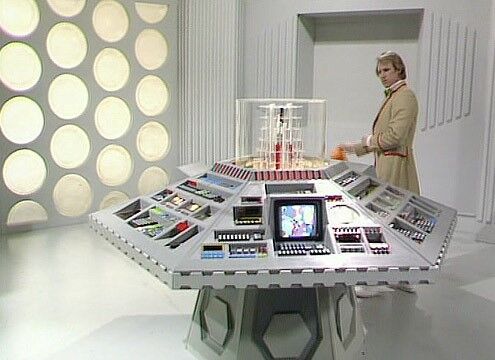
After the TARDIS's interior dimensions were damaged when it was stolen and piloted through a temporally unstable region, (PROSE: The Crystal Bucephalus) the interior was completely refurbished, giving the control room a sleeker, more high-tech appearance. The columns were now rectangular rather than cylindrical, and the roundelled walls now deeper inset. (TV: The Five Doctors [+]Terrance Dicks, Doctor Who 20th Anniversary Special (Public Broadcasting Service, 1983).) Following his regeneration, (TV: The Caves of Androzani [+]Robert Holmes, Doctor Who season 21 (BBC1, 1984).) it would be used by his next two incarnations, the Sixth and Seventh Doctors. (TV: The Twin Dilemma [+]Anthony Steven, Doctor Who season 21 (BBC1, 1984)., Time and the Rani [+]Pip & Jane Baker, Doctor Who season 24 (BBC1, 1987).)
After the Doctor, Ace and Hex did some "redecorating" to create the "Victorian" console room, (AUDIO: The Settling) this console room would be retired, briefly being reused as the console room of the original TARDIS after it materialised inside the "Black TARDIS", which used the "Victorian". The Black TARDIS was eventually destroyed, restoring the console room to its Victorian style. (AUDIO: Black and White)
The console in this room was duplicated by a matter-manipulating entity that the First Rani had enslaved to do her bidding, seeking to replace the console room of her own TARDIS after the Tremas Master had separated it from the rest of her ship to save himself from a tyrannosaurus rex. (TV: The Mark of the Rani [+]Pip & Jane Baker, Doctor Who season 22 (BBC1, 1985).) For a time, this console was used as an Oracle by the population of Alexandria in a duplicated version of Ancient Egypt that the entity had created by accident. The people accessed its databanks to learn about future technology. The duplicate console was eventually connected to the Rani's TARDIS, allowing her to control her ship once again. (PROSE: State of Change)
- The exact order of the TARDIS control rooms between Survival and Doctor Who is unclear and even contradictory.
Yellow
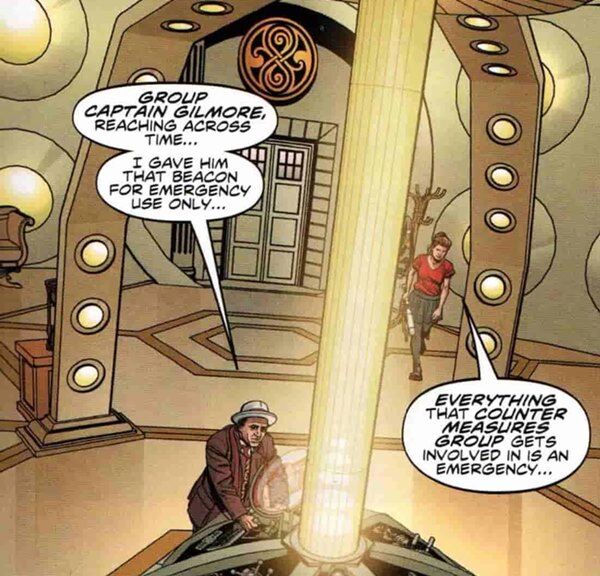
At one point during his travels with Ace, the Seventh Doctor had a control room with roundels on the beige (COMIC: The Armageddon Gambit [+]Error: Code 2 - no data stored in variables, cache or SMW.) or white (COMIC: Operation Volcano [+]Error: Code 2 - no data stored in variables, cache or SMW.) walls and arches giving off yellow light. Instead of the floor, the control console was attached to the ceiling by the time rotor. This control room contained a bookshelf, a spiral staircase, a gramophone, a grandfather clock, a chair, a lamp, and various chests. The Seal of Rassilon was located above the TARDIS doors, which had taken on the appearance of the exterior police box doors. (COMIC: The Armageddon Gambit [+]Error: Code 2 - no data stored in variables, cache or SMW., Operation Volcano [+]Error: Code 2 - no data stored in variables, cache or SMW.)
Beige

During his travels with Ace, the Seventh Doctor had a new control room prior to encountering the Timewyrm. (PROSE: The New Adventures Prologue) This interior briefly became a forest due to the TARDIS's interior dimensions being altered by the Doctor's signet ring interfacing with the chameleon circuit icon system. (COMIC:The Chameleon Factor [+]Paul Cornell, DWM Comics (Marvel Comics, 1991).') Now featuring angular walls with non-angular roundels, the roof now resembled the canopy seen in the First Doctor's console room. (COMIC:The Chameleon Factor [+]Paul Cornell, DWM Comics (Marvel Comics, 1991).', Metamorphosis [+]Paul Cornell, Doctor Who Yearbook comic stories (Marvel Comics, 1992)., The Last Word)
Round Console

At one point during his travels with Ace and Bernice Summerfield, the Seventh Doctor had reverted to using his grey control room. While the Doctor and other were inside it, the interior inexplicably changed into a unique interior with a round control console with no comment from the Doctor or others. (COMIC: Final Genesis [+]Warwick Gray, DWM Comics (Marvel Comics, 1993).)
Alternate universe TARDIS
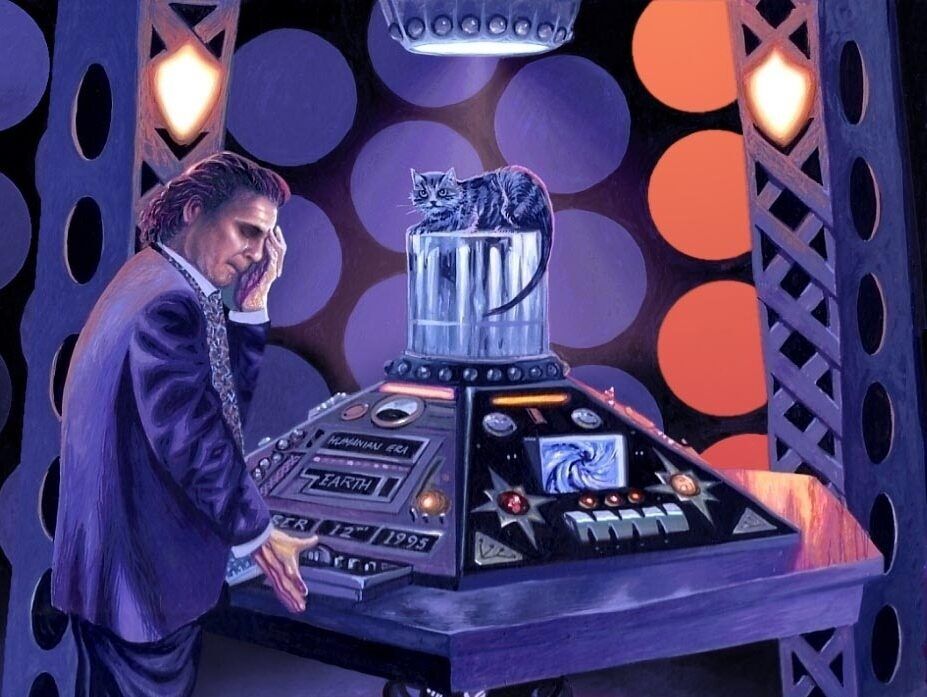
While travelling in an alternate universe, the Seventh Doctor lost his TARDIS while the one of his dead Third Doctor counterpart was re-activated and became isomorphically linked to Ace, causing it to create interior dimensions again. (PROSE: Blood Heat [+]Jim Mortimore, Virgin New Adventures (Virgin Books, 1993).) The Doctor kept it until he got back his own. (PROSE: Blood Heat - Happy Endings)
The console room contained an Edwardian chaise longue and, within one of the roundels, a thermos of coffee. (PROSE: Blood Heat [+]Jim Mortimore, Virgin New Adventures (Virgin Books, 1993).) It also contained a basket chair and a hatstand. (PROSE: The Dimension Riders)
Following Ace's departure, the interior took on the appearance of wood-panelled corridors. (PROSE: Sanctuary) After being given a cat by Joan Redfern, the Seventh Doctor had an early version of the Victorian parlour interior where the time rotor was not connected to the ceiling and had a wall of roundels. (PROSE: Human Nature [+]Paul Cornell, Virgin New Adventures (Virgin Books, 1995).)
It later returned to the Grey interior. (PROSE: Head Games)
Victorian parlour
At some point, the Seventh Doctor began to use a new control room, one that resembled a comfortable Victorian parlour. This design was later inherited by the Eighth Doctor. (TV: Doctor Who [+]Matthew Jacobs, Doctor Who Television Movie (Fox Broadcasting Company, 1996).)
River Song was known to have loved this version of the room, (GAME: The Eternity Clock) while Charlotte Pollard and the Fourth Doctor found it in poor taste. (AUDIO: The Stones of Venice, The Light at the End) Harry Sullivan and Naomi Cross did not like it, not deeming it "spaceshippy" enough. (AUDIO: Scream of the Daleks)
After later consoles, the Eighth Doctor would later restore or copy this console. (AUDIO: Storm Warning, The Great War)
Origin
Accounts differed over how and why this version of the control room was created or came in use. Although the Eighth Doctor claimed that it was the "second" control room (in actuality the intended primary control room) after a spot of remodeling, many accounts suggested that it was physically the same room as the white control room used by previous incarnations of the Doctor, but had been altered for a variety of conflicting reasons.
- An early version was already being used by the Seventh Doctor in the alternate universe TARDIS when he was given Wolsey. (PROSE: Human Nature [+]Paul Cornell, Virgin New Adventures (Virgin Books, 1995).)
- The TARDIS herself changed the room after being trapped inside the Doctor's family estate, the House of Lungbarrow. It rebuilt itself to resemble the house after the Doctor temporarily severed the link between the interior and exterior to prevent his family stealing the ship. After he had restored the TARDIS, the console room retained this homier design (PROSE: Lungbarrow [+]Marc Platt, adapted from Lungbarrow, Virgin New Adventures (Virgin Books, 1997).)
- The Doctor, Ace and Hex did some "redecorating" of the TARDIS. (AUDIO: The Settling) The Doctor's original TARDIS' console room would briefly revert back to its previous design after it dematerialised from the pocket dimension he had used to imprison the Elder Gods Albert and Peggy, leaving Ace and Hex behind, while his newly grown "Black TARDIS" used its "mother"'s Victorian configuration up until its eventual destruction. (AUDIO: Black and White) Following this, the TARDIS console room was restored to its Victorian layout, (AUDIO: Gods and Monsters) being briefly changed to a white configuration after To'Koth used it to return to the home dimension of the Elder Gods, (AUDIO: Signs and Wonders) before reverting to the Victorian layout. (AUDIO: Fiesta of the Damned)
- The Doctor — and not the TARDIS – had simply "built" it. (AUDIO: Excelis Decays)
Description

Its comparatively vast interior was significantly larger than any that had come before or after. In this version, the console itself was not the sole focus of the room, but merely one of its many features. A vast bureau almost entirely covered one wall, its huge drawers filled with various objects the Doctor wished to retain. Surrounding the console itself were several metal half-arches, covered in circular holes resembling roundels. Clocks of all description — but mostly mechanical ones — littered various nooks and crannies. Far from the evenly lit, mostly white interior of the past, this control room had multiple light sources and an abundance of wooden surfaces, which allowed the Doctor to create a sense of warmth and even opulent comfort. At least a portion of the Doctor's books were in another alcove, forming a sort of en suite library. (TV: Doctor Who [+]Matthew Jacobs, Doctor Who Television Movie (Fox Broadcasting Company, 1996).)
Furniture, usually anathema to the Doctor's control rooms, was found in abundance here. Indeed, there was a large area immediately adjacent larger than the console area itself, which had several comfortable chairs, lamps, an ottoman — all of which conspired to give this control room the appearance of a cosy living room.
Above it all was a scanner the size of the entire ceiling. The Doctor could flip a switch on his console and reveal astronomical phenomena on a grand scale. (TV: Doctor Who [+]Matthew Jacobs, Doctor Who Television Movie (Fox Broadcasting Company, 1996)., PROSE: War of the Daleks)
According to companion Will Arrowsmith, this console room was not "proper Victorian" but "pseudovictorian" and apparently heavily inspired by H. G. Wells' story The Time Machine, though based more upon the movie adaptation rather than the novel itself. (AUDIO: Persuasion)
Edifice
Following the TARDIS' destruction after it was caught in a dimensional tear, (PROSE: The Shadows of Avalon) it reconstructed itself into a massive, bone-like structure that came to be known as the Edifice. Its console room at this stage was apparently based on the console room at the time of destruction, but appeared, like the rest of the ship, to be made of bone. This was due to the TARDIS containing the Faction Paradox biodata virus that had infected the Third Doctor after his early regeneration. (PROSE: Interference - Book Two, The Ancestor Cell [+]Peter Anghelides and Stephen Cole, BBC Eighth Doctor Adventures (BBC Books, 2000).) The console also manifested an 'avatar' of the Third Doctor composed of the dust in the ship, apparently the manifestation of the Third Doctor who should have existed before the Faction changed his history. This console room was 'destroyed' when the Doctor drained the Edifice of all its power in order to fire the ship's ancient weapon systems, erasing the Dust regeneration from history and forcing the TARDIS to spend the next century repairing itself. (PROSE: The Ancestor Cell [+]Peter Anghelides and Stephen Cole, BBC Eighth Doctor Adventures (BBC Books, 2000).)
Post War in Heaven
The TARDIS completed its regeneration on Earth, after the Doctor exhausted its power in the destruction of Gallifrey. Its interior now resembled a mixture of the original console room and the library-like room often associated with the Eighth Doctor. (PROSE: Escape Velocity) The console was initially octagonal, (PROSE: The Slow Empire) but was later reconfigured to be pentagonal. (PROSE: Trading Futures) The Control Room eventually became hexagonal and contained four alcoves, two on either side of the main doors and the interior door. One contained filing cabinets and chests, another led to the TARDIS library, the third contained a laboratory, and the fourth contained a kitchen (which looked out onto an English countryside vista and was an exact replica of the kitchen in the Doctor's house in Kent). This interior was destroyed when the Doctor used the TARDIS to contain the explosion of a cold fusion generator created by the TARDIS' original owner. (PROSE: The Gallifrey Chronicles)
Victorian parlour again
The Eighth Doctor would use his original parlour console room later in his life during his adventures with Charley Pollard, (AUDIO: Storm Warning) Lucie Miller, (AUDIO: Blood of the Daleks) Molly O'Sullivan, (AUDIO: The Great War) Liv Chenka and Helen Sinclair. After the TARDIS was drained by the Ravenous and crashed in 2020, the interior collapsed. (AUDIO: Lost Property) When the TARDIS began to restore itself after latching onto a paradox, the console room was on “window mode” enabling the crew to see the TARDIS' surroundings whilst indoors, including whilst in flight. (AUDIO: Divine Intervention, Dead Time, Baker Street Irregulars)

The Eighth Doctor was still using the original parlour room during his travels with Josie Day (COMIC: Music of the Spherions) as well as during the Last Great Time War (PROSE: Natural Regression, Ghost of Christmas Past, AUDIO: Lies in Ruins) and at the time of his regeneration. (PROSE: The Day of the Doctor)
War console
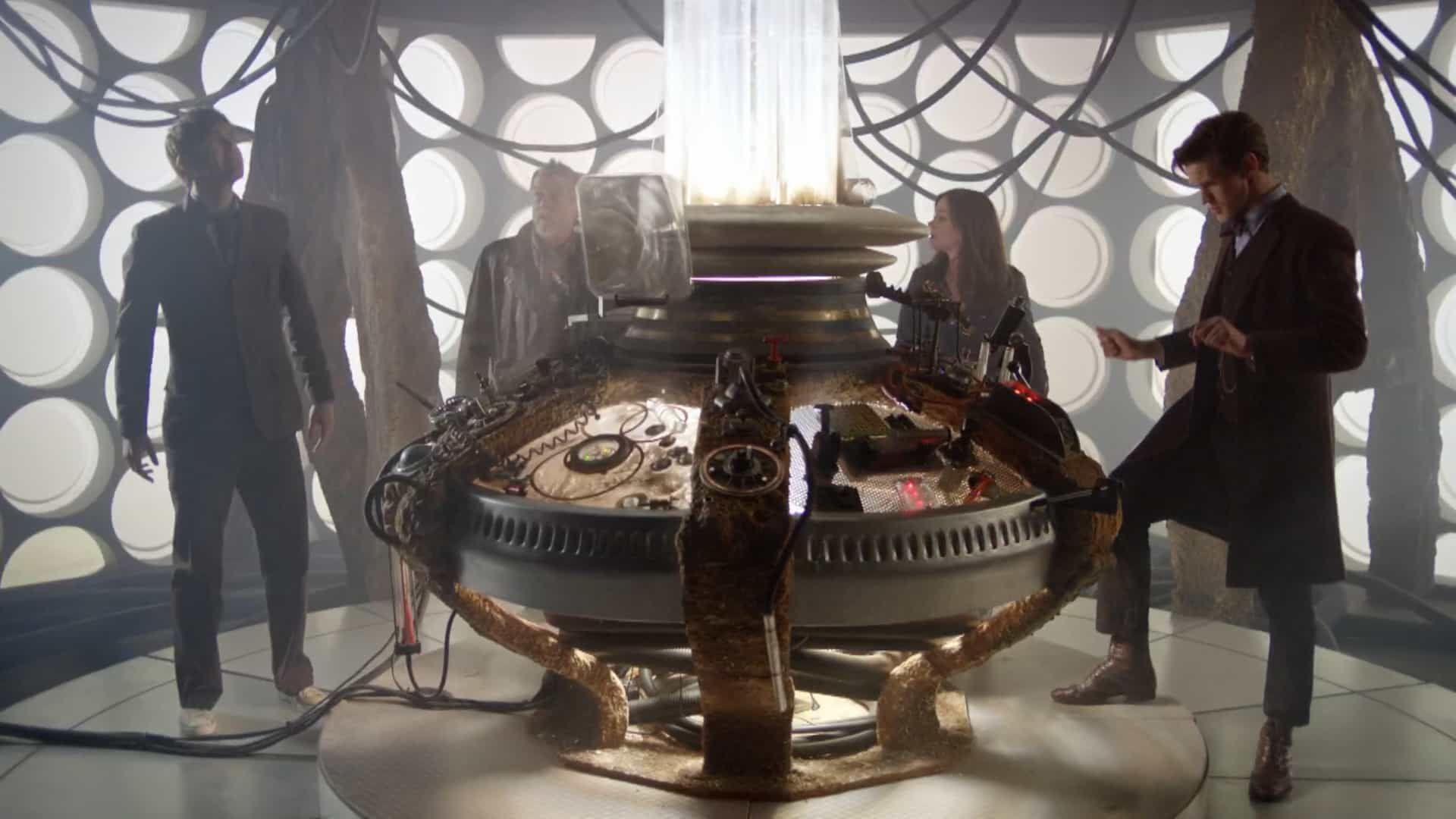
The War Doctor used a control room during the Last Great Time War, this time reminiscent of his first incarnation's control room with similar white walls and roundels, albeit with new coral support beams and a matching console, which incorporated many odds and ends, ranging from a device like a bicycle pump to a mallet used for percussive maintenance. This console was inherited by the Ninth Doctor. The entire room looked as though it had been built from spare parts. Examples included the wiring and circuitry laid out around the outside of the platform the console was set on, the platform itself was clean and tidy where as everything else was dirty. (TV: The Day of the Doctor [+]Steven Moffat, 50th Anniversary Specials (BBC One, 2013).) It had Police Box doors and the roof was a white dome rising from the walls which could become transparent. The control room was also linked to the other rooms in the TARDIS via an ascending staircase. (PROSE: Engines of War)
Coral console
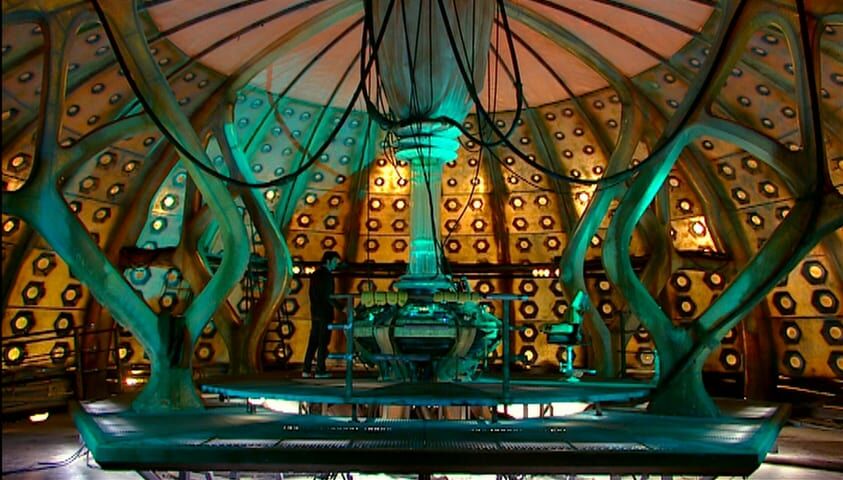
Early during the Ninth Doctor's life, the control room had been changed to its "coral" theme. This organic design was similar to its previous iteration used by the War and Ninth Doctors during and after the Last Great Time War respectively. However, the walls were now golden, with smaller, hexagonal impressions replacing the white roundels of the previous console room. This iteration of the console had apparently been available as early as the era of the Fifth Doctor, who disliked it, considering it worse than the "leopard skin" version. (TV: Time Crash [+]Steven Moffat, Doctor Who Children in Need Special 2007 (BBC One, 2007).) This control room was inherited by the Tenth Doctor. (TV: The Parting of the Ways) The Eleventh Doctor reflected on this console as his "grunge phase", (TV: The Day of the Doctor [+]Steven Moffat, 50th Anniversary Specials (BBC One, 2013).) which he grew out of. (TV: The Eleventh Hour [+]Steven Moffat, Doctor Who series 5 (BBC One, 2010).)
The console room consisted of a circular area, with a red-tiled ramp leading from the doors to a hexagonal platform. On the platform was a second, circular platform. There was also a set of jump seats situated on the other side of the platform, but were occasionally moved. (TV: Rise of the Cybermen) The control room had a doorway to a spiral staircase that led to the TARDIS laundry room and wardrobe. (COMIC: Laundro-Room of Doom)
The Doctor and companions would recline in the jump seats frequently. The entire room was supported by six coral pillars arranged in a hexagonal pattern that met with the top of the time rotor at the room's ceiling. There were also several black wires connecting to the time rotor. Under the main platform were storage areas large enough for the Doctor to enter himself to retrieve items, (TV: Army of Ghosts) though some were packed to just below the top. (TV: The Unicorn and the Wasp) It was also dim, illuminated by the glow of green or cyan light from the time rotor column in the centre of the room and the lights in the hexagons on the walls. (TV: Rose - Doomsday) However, the glow was later made less noticeable as the Doctor used the other lights. (TV: The Runaway Bride - The End of Time)

After stealing the TARDIS, the Saxon Master cannibalised it into a paradox machine, performing modifications to the control room. The room was illuminated in red and the console was enclosed inside a metal cage, with tubes and appendages attached to it including a pipe at its base connecting to another area of the TARDIS, with a dial showing a readout of the pressure build-up inside. Jets of steam came off the console whilst the paradox machine activated. (TV: The Sound of Drums) Jack Harkness destroyed the machine by shooting the console, causing the control room to ignite. The Doctor subsequently repaired the TARDIS, returning the interior to normal. (TV: Last of the Time Lords) During his repairs however he left the shields down, resulting in the TARDIS colliding with the Titanic, the front of which broke through a wall into the control room. The Doctor was able to quickly repair the wall. (TV: Voyage of the Damned)
The console room was set on fire and at least one column destroyed by the Tenth Doctor's violent regeneration into his eleventh incarnation. Much of the wiring in the ceiling fell apart and parts of the console exploded. The damage to the console was extensive enough to cause the Door Release Lever to malfunction. The Doctor nearly fell out of the TARDIS. (TV: The End of Time, The Eleventh Hour [+]Steven Moffat, Doctor Who series 5 (BBC One, 2010).)
It was rebuilt by the TARDIS, but it decided to replace it with another version of the console room and archive the coral desktop. When House had control of the TARDIS, Idris, the separated matrix of the TARDIS, telepathically directed Rory Williams and Amy Pond to it along with the passcode of "crimson, delight, eleven, petrichor." Rory was then able to use the still functional control room to lower the TARDIS' shields, allowing the Junk TARDIS to land within the control room, killing Nephew. House deleted the room for the power needed to leave the bubble universe he was in and enter N-Space, but a hardwired fail-safe transported the Doctor and his companions to the primary control room where the TARDIS matrix was able to reenter the ship and get rid of House. (TV: The Doctor's Wife [+]Neil Gaiman, Doctor Who series 6 (BBC One, 2011).)
Copper console
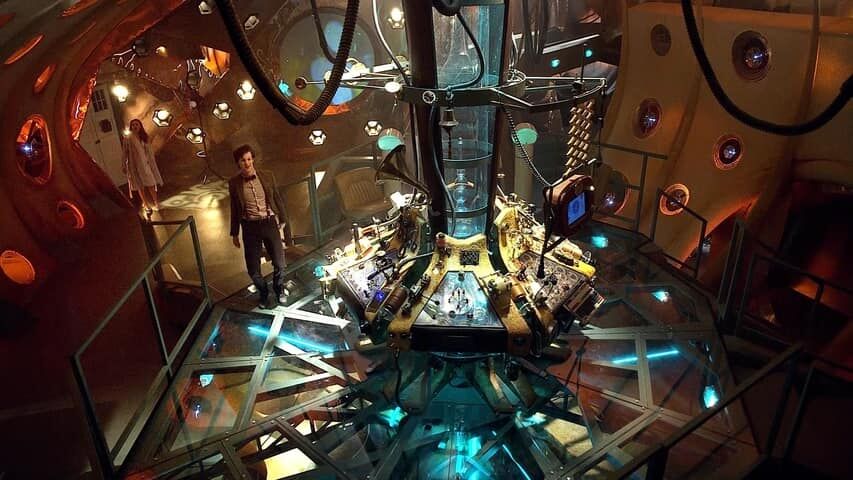
Due to the violent nature of the Tenth Doctor's regeneration and the resultant damage to the TARDIS, it required time to repair itself. After the ordeal involving the Atraxi attempting to recapture Prisoner Zero had been resolved, the Eleventh Doctor returned to the TARDIS and, upon seeing the replacement control room, immediately took the TARDIS to the Moon and back to Earth to "run her in", though accidentally travelled forward two years in doing so. Soon after taking Amy Pond on board for the first time, the new TARDIS console also provided the Doctor with a new sonic screwdriver, as the previous one had been destroyed. (TV: The Eleventh Hour [+]Steven Moffat, Doctor Who series 5 (BBC One, 2010).)
Changes to the control room included a new hexagonal console with instruments resembling a typewriter, a telegraph, a gramophone, a set of hot and cold taps, and a view-screen made by Magpie Electricals. A larger, circular, secondary view screen was set into one of the walls. (TV: The Beast Below, Victory of the Daleks, The Hungry Earth, Cold Blood, The Girl Who Waited) There were fewer roundels on the walls than in the past, and an area located underneath the main console which housed the Heart of the TARDIS. This version also possessed an actual phone on the console, through which people could call the Doctor. (TV: Victory of the Daleks, The Big Bang, Bad Night) There was also a swing located under the glass floor the Doctor or anyone else could sit on to help with maintenance. (TV: The Vampires of Venice, Amy's Choice, The Pandorica Opens, Space) The railings originally were rectangular barred and black in colour, (TV: The Eleventh Hour [+]Steven Moffat, Doctor Who series 5 (BBC One, 2010).) but later became round barred and gold. (TV: A Christmas Carol, et al.)
It had at least three floors: a lower section, the console room level, and the second level. (TV: The Eleventh Hour [+]Steven Moffat, Doctor Who series 5 (BBC One, 2010).) Unlike its immediate predecessor, this console room had three visible exits to the rest of the TARDIS; two on the lower levels and one via a set of stairs. (TV: The Eleventh Hour [+]Steven Moffat, Doctor Who series 5 (BBC One, 2010). - The Angels Take Manhattan)
Other control room

At one point in his travels with Alice Obiefune, while Amy and Rory were on their honeymoon, the Eleventh Doctor had a new control room with console similar to his second control room and yellow and green glowing roundels on the walls. (COMIC: Without a Paddle) He would revert to his first control room when he reunited with the Ponds. (TV: A Christmas Carol, The Impossible Astronaut)
Neon console
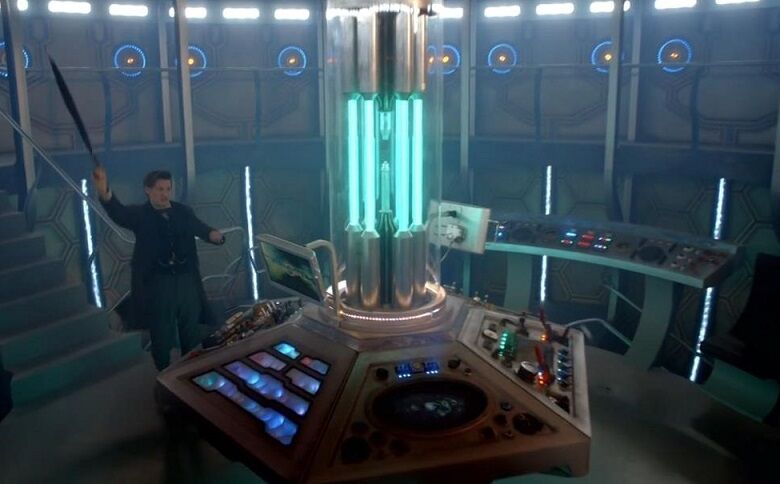
After his loss of the Ponds, the Eleventh Doctor cut himself off from the universe by hiding in Victorian London. Writing in his diary, he considered redecorating the TARDIS. (PROSE: The Doctor's Diary [+]Moray Laing, The Official 50th Anniversary Annual (Penguin Group, 2013). Page 9.) He decided to do so, dispensing his more whimsical control room in favour of a seemingly smaller control room, containing a console with more literal input devices and instrumentation, as well as a pair of secondary consoles on the railing of the main platform. The room was stark and mechanical, covered in tones of teal and aqua, and an overall cold mood to reflect a more sorrowful Doctor. (TV: The Snowmen [+]Steven Moffat, Doctor Who Christmas Special 2012 (BBC One, 2012)., etc.)
This control room was inherited by the Twelfth Doctor, (TV: The Time of the Doctor [+]Steven Moffat, Doctor Who Christmas Special 2013 (BBC One, 2013).) who proceeded to upgrade the console room by adding several items to it, including a reclining chair, bookshelves, candles, chalkboards, an additional staircase to the upper level and circular lights around the lower balcony. He also changed the lighting of the time rotor and room from its original aqua to orange, creating an ambient glow that added warmth to the room. Overall, he gave the once empty and stark control room a homelike sense of decor, provision, and sophistication. (TV: Deep Breath) Bill Potts described it as "like a really posh kitchen". (TV: The Pilot) By contrast, the First Doctor disapproved of its aesthetic, calling it "a restaurant for the French". (TV: Twice Upon a Time [+]Steven Moffat, Doctor Who Christmas Special 2017 (BBC One, 2017).)
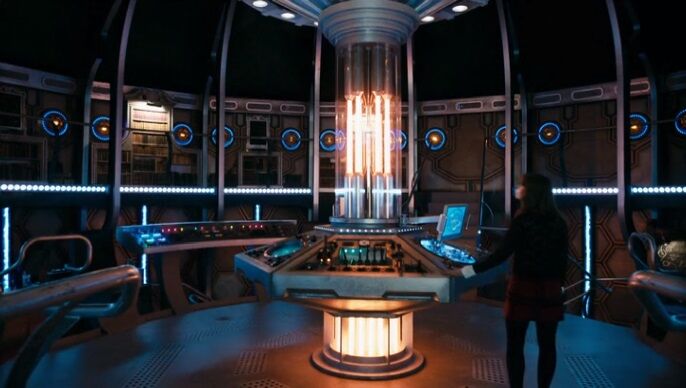
The Twelfth Doctor later expanded his renovation of the control room further, adding glowing circles over the hexagonal roundels on the lower floor, echoing the circular roundels of his earlier control rooms. (COMIC: Day of the Tune, TV: The Magician's Apprentice)
The control room that Clara Oswald knew featured aqua/orange lighting and time rotor, Gallifreyan markings on the ceiling and above the time rotor, hexagonal roundels on the lower console level, and Gallifreyan markings on the top level. Several tiny lights went around the walls of the room in a straight line, flashing sections at a time. The console featured two screens, and what seemed to be a radar on one face. There were two additional consoles around the edge of the main level. It was also much darker than the previous iteration. Except for the time rotor, all lights could be turned off when the Doctor was not inside.
There were three levels: an upper balcony, which looked down over the console and had doorways off of it, the landing, which housed the console, seating, and main doors (TV: The Snowmen [+]Steven Moffat, Doctor Who Christmas Special 2012 (BBC One, 2012).) and the lower level, which had several compartments, one of which contained clothing. The Eleventh Doctor assembled his new attire from the clothes held in this compartment. (TV: The Bells of Saint John [+]Steven Moffat, Doctor Who series 7 (BBC One, 2013).) Another compartment allowed access to the Heart of the TARDIS and could expose objects placed in there to time winds. (TV: The Time of the Doctor [+]Steven Moffat, Doctor Who Christmas Special 2013 (BBC One, 2013).) There were four doorways to other sections of the TARDIS, two on the upper level either side of the main doors, and two on the lower level. One of the compartments under the console contained a ladder leading to a lower part of the TARDIS whilst one of the roundels on the lower section of the wall opened to reveal a passageway that led to the engine room at the centre of the TARDIS. (TV: Journey to the Centre of the TARDIS)

This console room initially lacked a hatstand, a factor which even the Doctor hadn't noticed until asked about it by Clara. (TV: Hide) The Twelfth Doctor's redecorated console room once more included the hatstand, located on the lower level. (TV: Mummy on the Orient Express [+]Jamie Mathieson, Doctor Who series 8 (BBC One, 2014).)
The roundels contained a hidden stash of alcohol which River Song would drink whenever she borrowed the TARDIS. (TV: The Husbands of River Song [+]Steven Moffat, Doctor Who Christmas Special 2015 (BBC One, 2015).) The First Doctor apparently started this as he kept brandy in a similar location within his own TARDIS, and expressed annoyance at how some of the contents had been drunk by the time of the Twelfth Doctor. (TV: Twice Upon a Time [+]Steven Moffat, Doctor Who Christmas Special 2017 (BBC One, 2017).)
The console eventually sustained heavy damage following the Twelfth Doctor's explosive regeneration, scattering sparks from various control surfaces, and even allowing a portion of the central console to separate from the time rotor. Such extensive damage to the control room made the TARDIS tip onto its side, causing the newly regenerated Thirteenth Doctor, and most of her books, to fall from the ship, over Earth. Fire completely engulfed the control room right before the TARDIS vanished. (TV: Twice Upon a Time [+]Steven Moffat, Doctor Who Christmas Special 2017 (BBC One, 2017).)
Crystal console
Due to the Twelfth Doctor holding his regeneration back for too long, the console suffered major damage, causing the TARDIS to malfunction and drop the Thirteenth Doctor out as it vanished (TV: Twice Upon a Time [+]Steven Moffat, Doctor Who Christmas Special 2017 (BBC One, 2017).) to Desolation in a materialisation loop. The TARDIS remained on Desolation for centuries trapped in the loop, and it was known as "the Ghost Monument" by Desolation's former inhabitants. When the Doctor and her friends arrived at Desolation, they found that the TARDIS had taken on a new interior appearance after undergoing a self-regeneration to repair itself from the damage that the regeneration did. (TV: The Ghost Monument [+]Chris Chibnall, Doctor Who series 11 (BBC One, 2018).)
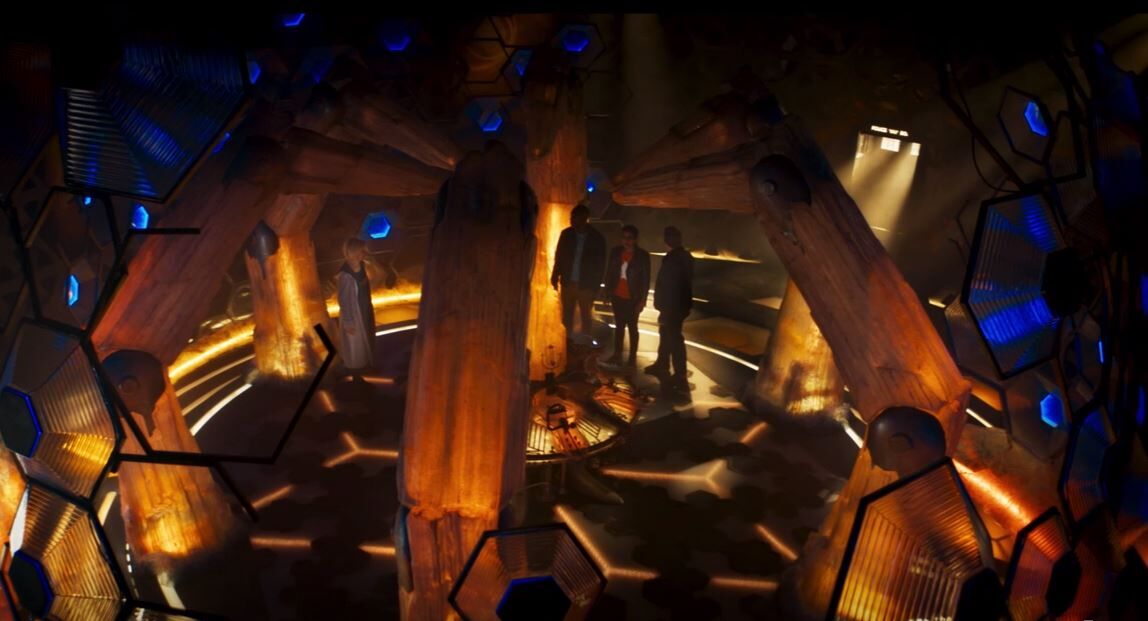
The entrance to the TARDIS had the side walls of the inside of the police box, while the back of it led into the main control room. The walls of the TARDIS were made of non-connected walls made of hexagons containing a cog-like pattern. There were also a few blue lights in the walls, along with a hexagonal monitor, as well as a metal cage-like framework around the console platform with hexagonal shapes. (TV: The Ghost Monument [+]Chris Chibnall, Doctor Who series 11 (BBC One, 2018).) In place of a proper monitor at the console was a blue holographic image on the side. It only displayed Gallifreyan language. (TV: Rosa [+]Malorie Blackman and Chris Chibnall, Doctor Who series 11 (BBC One, 2018).)
The console itself lacked a conventional time rotor, which was replaced with a giant crystal that glowed orange while in use. Six other crystals were formed around the console. Instead of keyboards, there were more steampunk-ish controls such as levels and nobs. There was even a tiny replica of the TARDIS on the console, which spun when the TARDIS was in flight. To the Thirteenth Doctor's surprise, the console also included a foot pedal; upon pressing it, a dispenser on the console would produce biscuits. (TV: The Ghost Monument [+]Chris Chibnall, Doctor Who series 11 (BBC One, 2018)., COMIC: The Forest Bride) This console also had a telepathic circuit of its own kind, as used by Yaz when travelling back in time to visit her grandmother's wedding. (TV: Demons of the Punjab [+]Vinay Patel, Doctor Who series 11 (BBC One, 2018)., The Battle of Ranskoor Av Kolos [+]Chris Chibnall, Doctor Who series 11 (BBC One, 2018).) The Memory TARDIS had a smaller version of this crystal console in the middle of the floor which gave off the appearance of a campfire in that TARDIS. (TV: Tales of the TARDIS, Empire of Death [+]Russell T Davies, Doctor Who series 14 (BBC One and Disney+, 2024).)
The giant crystal taking the place of the time rotor could be seen rising and falling while the TARDIS was in flight. (TV: Rosa [+]Malorie Blackman and Chris Chibnall, Doctor Who series 11 (BBC One, 2018).) The top parts of the surrounding crystals would also move along with the central crystal, like an arm. (TV: Demons of the Punjab [+]Vinay Patel, Doctor Who series 11 (BBC One, 2018).)
The blue lights in the framework around the console platform replaced generic roundels as access to circuitry (TV: The Battle of Ranskoor Av Kolos [+]Chris Chibnall, Doctor Who series 11 (BBC One, 2018).) and general storage. (TV: Revolution of the Daleks, The Power of the Doctor [+]Chris Chibnall, Doctor Who Centenary Special 2022 (BBC One, 2022).) The Doctor referred to them as 'portals'. (TV: The Battle of Ranskoor Av Kolos [+]Chris Chibnall, Doctor Who series 11 (BBC One, 2018).)
At some point after the Doctor's encounter with a Dalek reconnaissance scout, (TV: Resolution) the TARDIS had added a few new features to the control room. Near the back of the room was a set of stairs made of hexagonal steps leading to a small platform, as well as a doorway leading deeper into the interior; the six crystals surrounding the console were now stationary at all times, and had more sturdy-looking supports at their bases; above the console, directly over the giant crystal, sat a second, similar crystal pointing down from a spherical protrusion made of the same hexagonal framework around the control room; and on the console, new holographic moniters had been installed, allowing a display of images for the Doctor and her companions to see. (TV: Spyfall) Towards the entrance there was also a bioreading synthesizer that could ascend from and descend back into the floor activated from the console, which was used to scan and prepare antidotes, (TV: Praxeus) whose top panel could function as a table. (TV: Orphan 55)
When time began running wild due to the Flux damaging the Temple of Atropos, the TARDIS began malfunctioning, resulting in deformities in the control room such as spikes growing from the walls, (TV: War of the Sontarans) black liquid oozing from the crystals surrounding the console and multiple police box doors. (TV: The Halloween Apocalypse) Once the Flux was resolved, the Doctor reset the TARDIS to resolve these problems, with the control room collapsing into a void whilst the ship reset. Afterwards the control room was restored to normal. (TV: Eve of the Daleks)
This console room was inherited by the Fourteenth Doctor (COMIC: Liberation of the Daleks, TV: Destination: Skaro), but eventually changed to a different appearance, seemingly on its own. (TV: The Star Beast)
Roundel TARDIS
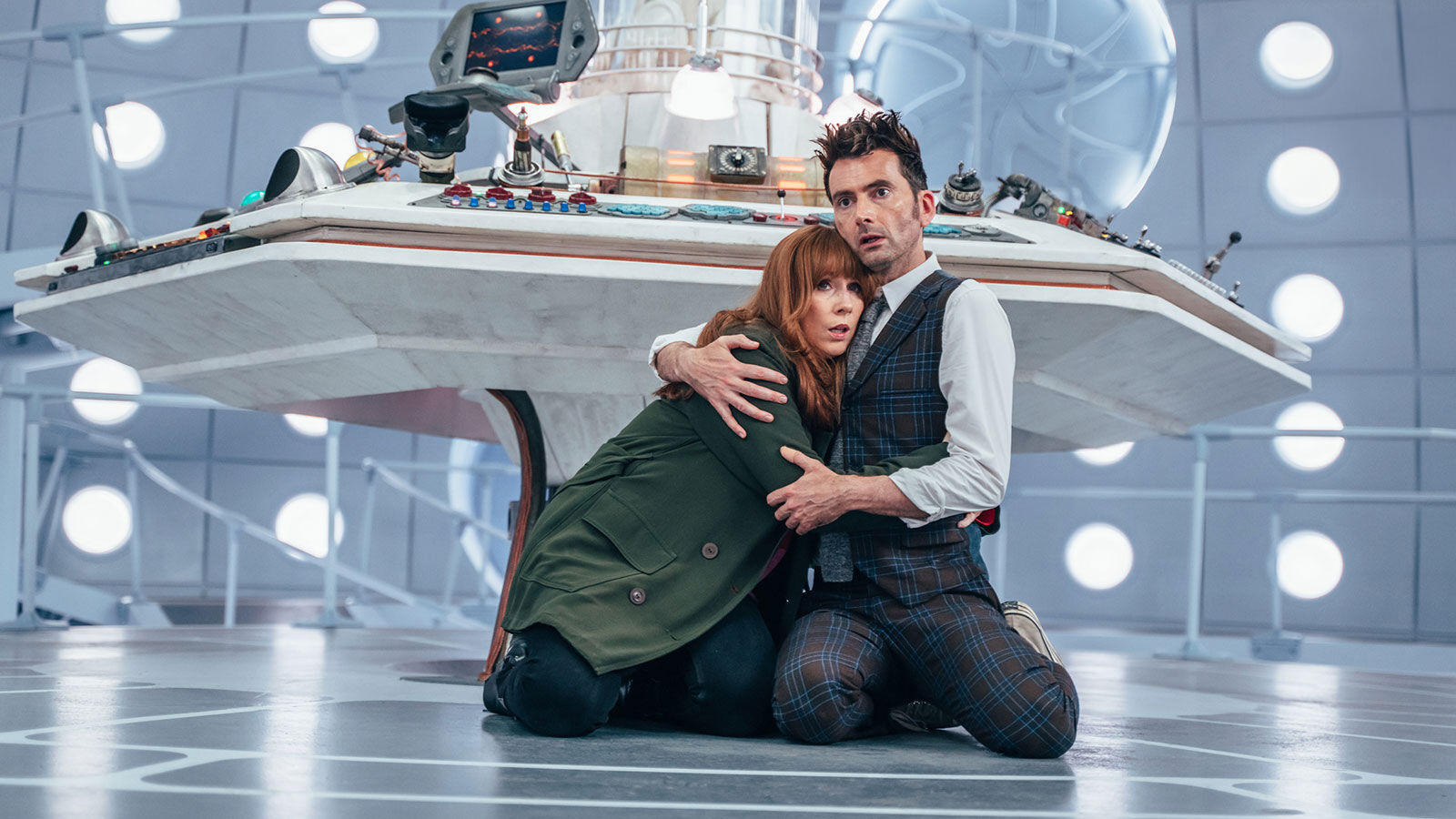
Following his adventure with Donna Noble and Beep the Meep, the Fourteenth Doctor returned to the TARDIS to find the interior had changed, much to his delight. (TV: The Star Beast [+]Russell T Davies, adapted from Doctor Who and the Star Beast (Pat Mills and John Wagner), Doctor Who 2023 specials (BBC One and Disney+, 2023).)
The interior was now a curved room with roundels and multiple walkways dominating the area; the roundels provided most of the light in the room, and could change colour from white to orange, green, purple or blue. Similar to the interiors used by the Eleventh and Twelfth Doctors, the TARDIS had multiple levels, now accessed by ramps rather than stairs, and many doors leading deeper into the ship. The console remained in the centre of the room, and appeared to be a mix of built-in controls and spare parts. The time rotor once again connected to the ceiling, and contained an intricate internal mechanism, with a blue light inside, that rose and fell while the ship was in flight. Similar to the biscuit dispenser on the Thirteenth Doctor's console, one panel of the console housed a coffee maker. (TV: The Star Beast [+]Russell T Davies, adapted from Doctor Who and the Star Beast (Pat Mills and John Wagner), Doctor Who 2023 specials (BBC One and Disney+, 2023).) The scanner had returned to being a screen, albeit smaller than previous scanners, attached to the console via an arm that could rotate around the console, and had several buttons included. (TV: Wild Blue Yonder [+]Russell T Davies, Doctor Who 2023 specials (BBC One and Disney+, 2023).) Similar to the Eleventh Doctor's first control room, there also existed a second, larger pair of circular scanner screens built onto the wall, which could be activated by the Doctor's sonic screwdriver to perform and display a biological scan of a living person. (TV: Space Babies [+]Russell T Davies, Doctor Who series 14 (BBC One and Disney+, 2024).)
This control room was destroyed when Donna Noble accidentally spilled coffee on the console, causing the Doctor to complain that he'd liked the new design. When the Doctor triggered the TARDIS to regenerate from the damage, it simply repaired the console room, (TV: The Star Beast [+]Russell T Davies, adapted from Doctor Who and the Star Beast (Pat Mills and John Wagner), Doctor Who 2023 specials (BBC One and Disney+, 2023)., Wild Blue Yonder [+]Russell T Davies, Doctor Who 2023 specials (BBC One and Disney+, 2023).) rather than replacing it like the TARDIS did after regenerating from the Tenth and Twelfth Doctor's regenerations. (TV: The Eleventh Hour [+]Steven Moffat, Doctor Who series 5 (BBC One, 2010)., The Ghost Monument [+]Chris Chibnall, Doctor Who series 11 (BBC One, 2018).)
The angle of the floor just inside the door could be adjusted, which the Doctor used to fling the Not-thing impersonating Donna out of the ship. (TV: Wild Blue Yonder [+]Russell T Davies, Doctor Who 2023 specials (BBC One and Disney+, 2023).) The lever to do so was brand new at the time, either added in the redesign or when the TARDIS regenerated from the damage that Donna had accidentally caused. (PROSE: Wild Blue Yonder [+]Mark Morris, adapted from Wild Blue Yonder (Russell T Davies), 60th Anniversary Novels (_target Books, 2023).)
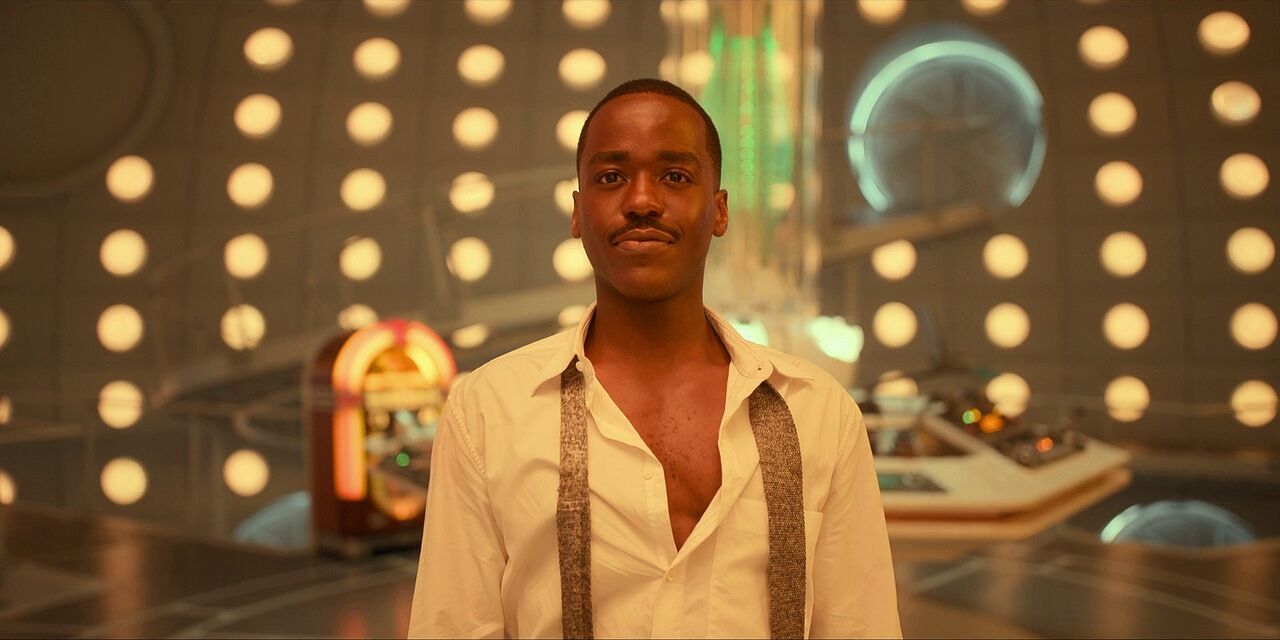
After the Fourteenth Doctor's bi-generation, the Fifteenth Doctor used the last remnants of the Toymaker's power to bi-generate the TARDIS, thereby inheriting this control room. The control rooms of both TARDISes were identical save the Fifteenth Doctor's one including a jukebox, which surprised the Fourteenth Doctor, and the addition of a wheelchair ramp that folded out from the bottom of the TARDIS doors. Before departing on his adventures, the Fifteenth Doctor changed the roundels' colour to orange. (TV: The Giggle [+]Russell T Davies, Doctor Who 2023 specials (BBC One, 2023).) When Ruby Sunday came aboard for the first time, the interior appeared white again, (TV: The Church on Ruby Road [+]Russell T Davies, Doctor Who Christmas Special 2023 (BBC One and Disney+, 2023).) although the Doctor was quick to demonstrate his control over the lighting by snapping his fingers and turning the lower half of the room orange and keeping the upper half a dimmer white. (TV: Space Babies [+]Russell T Davies, Doctor Who series 14 (BBC One and Disney+, 2024).)
When Sutekh took full control of the TARDIS, it took on a red lighting. However, the Doctor was able to change it back to normal and retake control of the TARDIS using a whistle provided to him by the Memory TARDIS. (TV: Empire of Death [+]Russell T Davies, Doctor Who series 14 (BBC One and Disney+, 2024).)
On the Doctor's command, a panel could slide open to reveal an aperture from which the Heart of the TARDIS could generate a powerful energy blast. (TV: Empire of Death [+]Russell T Davies, Doctor Who series 14 (BBC One and Disney+, 2024).)
The Doctor's other control rooms
Second control room
There existed a second, wooden control room which the Fourth (TV: The Masque of Mandragora [+]Louis Marks, Doctor Who season 14 (BBC1, 1976).) and Eighth Doctors claimed was actually the primary, original control room. (PROSE: The Dying Days [+]Lance Parkin, Virgin New Adventures (Virgin Books, 1997).) This control room in its original form was simpler and more compact than the white control room, with the console resembling a desk, no visible time rotor and all the controls hidden behind what appeared to be fold-down wooden flaps; one flap also had a writing desk beneath it. It had more subtle roundels, some of them framing stained glass windows. (TV: The Masque of Mandragora [+]Louis Marks, Doctor Who season 14 (BBC1, 1976)., The Hand of Fear [+]Bob Baker and Dave Martin, Doctor Who season 14 (BBC1, 1976)., The Deadly Assassin [+]Robert Holmes, Doctor Who season 14 (BBC1, 1976)., The Robots of Death [+]Chris Boucher, Doctor Who season 14 (BBC1, 1977)., The Invisible Enemy [+]Bob Baker and Dave Martin, Doctor Who season 15 (BBC1, 1977).)
The Eighth Doctor recalled having used the wooden control room "ages ago" when he wore a tricorn hat, before he had begun using the secondary, white control room. (PROSE: The Dying Days [+]Lance Parkin, Virgin New Adventures (Virgin Books, 1997).)
The entrance to the secondary room, which consisted of a wooden door with a stained glass window, stood out in the metallic corridors of the TARDIS.Polly, Ben and Jamie once stumbled upon the room while exploring the TARDIS. In a wooden chest there, they discovered an alien ouija board. (PROSE: Something at the Door)
When the Fourth Doctor found the control room again, he found a recorder and a smoking jacket there, suggesting both the Second and Third Doctors had this room at times. (TV: The Masque of Mandragora [+]Louis Marks, Doctor Who season 14 (BBC1, 1976).)
For a brief period, the Fourth Doctor used this as the main control room. (TV: The Masque of Mandragora [+]Louis Marks, Doctor Who season 14 (BBC1, 1976)., The Hand of Fear [+]Bob Baker and Dave Martin, Doctor Who season 14 (BBC1, 1976)., The Deadly Assassin [+]Robert Holmes, Doctor Who season 14 (BBC1, 1976)., The Robots of Death [+]Chris Boucher, Doctor Who season 14 (BBC1, 1977)., The Invisible Enemy [+]Bob Baker and Dave Martin, Doctor Who season 15 (BBC1, 1977).)
After destroying the console in the main control room, the Fifth Doctor and Tegan Jovanka retreated to the secondary control room to gain the advantage on Chaos; Tegan commented that the secondary control room looked like "Sherlock Holmes's back bedroom". (AUDIO: The Kamelion Empire)
While looking for a Kymbra Chimera which had invaded the TARDIS, the Sixth Doctor and Frobisher discovered it and Peri in the second control room. (COMIC: Changes)
Ace discovered the second control room whilst exploring the TARDIS, which she originally thought to be the Doctor's study, and once again the Doctor battled the Mandragora Helix from inside it. (COMIC: Distractions, The Mark of Mandragora)
At least one second control room was lost when the Seventh Doctor ejected the primary one from the TARDIS in an attempt to defeat Qataka, a megalomaniac who had downloaded her mind into the TARDIS, the Doctor having tricked her into thinking that the life support systems were controlled from that console. However, Qataka was able to use the console to turn herself into the godlike Timewyrm. (PROSE: Timewyrm: Genesys, Timewyrm: Revelation)
At one stage, the Seventh Doctor suspected that the secondary control room had been deleted, as he hadn't seen it in a while. (PROSE: Cat's Cradle: Time's Crucible)
The Eighth Doctor stated that the lush Victorian control room the Seventh Doctor used near the end of his lifetime (TV: Doctor Who [+]Matthew Jacobs, Doctor Who Television Movie (Fox Broadcasting Company, 1996).) was this second control room — in actuality the original, which he had neglected in favour of the "secondary" white control room for a long time, having undergone some alterations. (PROSE: The Dying Days [+]Lance Parkin, Virgin New Adventures (Virgin Books, 1997).) Hence, once he started using that original room again, the white control room became the "secondary control room". The Doctor went there after his memory was erased by the Bruce Master's trap. (PROSE: The Eight Doctors)
The Eighth Doctor was forced to again retreat to his secondary control room with Cardinal Ollistra, Doctor Eva Morrison and Commander Roxita when a group of Vashta Nerada infiltrated the ship, using a set of three spacesuits in this room as part of a plan to purge the Vashta Nerada from the TARDIS. At this time, the control room was once again made of simulated wood. (AUDIO: Day of the Vashta Nerada)
Others

There also existed a tertiary control room, which was cool, dark grey, and surrounded with broken pillars, having a small mushroom-shaped console in the middle. (PROSE: Nightshade, Sanctuary) While looking for the TARDIS library, the Second Doctor used the TARDIS pavilion and tertiary console room as a guide, but still got lost. (PROSE: The Roundheads)
Soon after the TARDIS became infected by an organic material from Tír na n-Óg, (PROSE: Cat's Cradle: Witch Mark) the Doctor began adapting the Zero Room into another console room, disconnected from the Universe, so he could escape the effects. This control room/zero room was lost when the Seventh Doctor ejected it from the TARDIS in an attempt to destroy the sentient computer, Pool. (PROSE: Deceit)
The Eighth Doctor used the quinary control room, which he thought that he hadn't used in a while, if ever, after Charlotte Pollard opened C'rizz's absolver and a psychic being partially destroyed the main control room. Charley said it smelt like an old woman's parlour. (AUDIO: Absolution)
During his tenth incarnation, the Doctor intimated that there may have been even more control rooms than were known to have been used. (COMIC: Tesseract)
As Idris, the TARDIS told the Eleventh Doctor it had so far archived thirty control rooms. The Doctor argued he had only changed the desktop theme a dozen times and it couldn't archive things that hadn't happened yet. The TARDIS merely replied that he couldn't. (TV: The Doctor's Wife [+]Neil Gaiman, Doctor Who series 6 (BBC One, 2011).)
Other TARDISes' control rooms
The Machine
Patience used the Machine, dating back from before the TARDIS themselves, which was dimensionally immanent: smaller on the inside than the outside.
Type 1

The Eleventh Doctor once travelled in a Type 1 TARDIS which lost its outer shell during one of its trips. (COMIC: The Lost Dimension [+]George Mann, et al., Titan summer events (Titan Comics, 2017).)
The Monk's TARDIS

The Meddling Monk used a Mark IV TARDIS, retaining the same white TARDIS interior as the Doctor's but with the console stood on a dais. (TV: The Time Meddler [+]Dennis Spooner, Doctor Who season 2 (BBC1, 1965).)
The Master's TARDISes
The Master's TARDISes had varied interiors. Some interiors seemed to mimic the Doctor's re-designs of their own TARDIS at the time of the encounter.
At one point, it was entirely similar to the Doctor's except with different furniture. (TV: Colony in Space)
Later he decorated the walls of the console room with concave "bowl" shaped structures instead of the regular roundels, with edges that jutted out from the wall, and featured shallower, non-backlit roundels for the half-roundels at the tops and bottoms of the walls. One of the roundels served as a scanner with a picture appearing in its centre. The only visible difference from the Third Doctor's TARDIS was the time rotor. (TV: The Time Monster [+]Robert Sloman, Doctor Who season 9 (BBC1, 1972).)
The Master's putrescent incarnation adopted a "new ship" with black wall interior and black opaque roundels. The controls were not on a central console but at a desk in front of the wall with two video screens linked to the exterior Melkur's eyes. A second TARDIS was hidden as a grandfather clock inside the control room. It also had white glass walls which led to the outside. (TV: The Keeper of Traken)

After stealing Tremas's body, the Master's TARDIS matched the grey interior of the Doctor's TARDIS, with black walls instead but keeping the roundels white. (TV: The King's Demons) It used the same console pattern of the Fifth, Sixth and Seventh Doctors' TARDIS. (TV: Planet of Fire [+]Peter Grimwade, Doctor Who season 21 (BBC1, 1984)., The Ultimate Foe)
Chronotis's TARDIS

Professor Chronotis changed the interior of his Type 12, Mark I TARDIS (PROSE: Shada) into the interior of a Cambridge office with the controls hidden inside the bookshelves. (TV: Shada [+]Douglas Adams, Doctor Who (1992).)
Omega's TARDIS
Omega operated a TARDIS with an interior similar to the Fifth Doctor's but with green roundels. It did not have a console, instead having its controls on the wall. (TV: Arc of Infinity)
The Rani's TARDIS
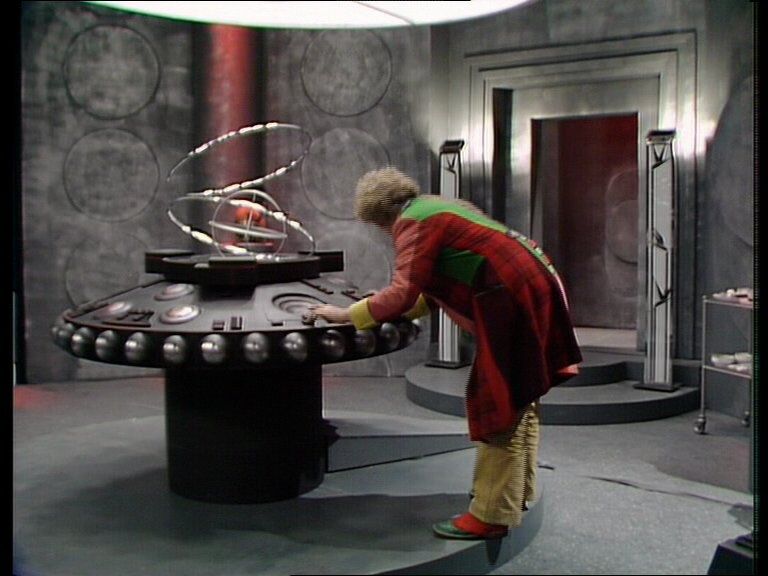
In place of a central column, the Rani's TARDIS had a rotating pair of metallic rings. The console also had interfacing controls in addition to buttons and switches. It used a holographic scanner which popped up from the main console. The walls of the console room looked like dark marble, with large, opaque roundels. It was linked to a Stattenheim remote. (TV: The Mark of the Rani [+]Pip & Jane Baker, Doctor Who season 22 (BBC1, 1985).)
At some point on the planet Lakertya, the Rani's TARDIS went under a new control room, much couldn't be seen other than its walls being plain white walls and there being no control panel in sight. (TV: Time and the Rani [+]Pip & Jane Baker, Doctor Who season 24 (BBC1, 1987).)
Kairel's TARDIS
Lord Kairel had a TARDIS with an unique time rotor design set in a circular room with its wall covered in hexagons. Some Greek pillars were set in the room but not inside the walls. (COMIC: The Stolen TARDIS)
Cargan's TARDIS
Academy's graduate Cargan had his TARDIS fiited with the "bowl" design used by the Third Doctor and the Master. (COMIC: Minatorius)
Tubal Cain's TARDIS
Tubal Cain commanded a complete CIA team inside a TARDIS more akin to a command centre than the usual TARDIS designs. (COMIC: The Stockbridge Horror)
Celestial Omnibus
Iris Wildthyme's TARDIS control room looked like a modified double-decker bus, though with a few hints of its true nature. (PROSE: Old Flames) The controls were on the dashboard and resembled those of the Victorian parlour. (PROSE: The Scarlet Empress)
Junk TARDIS
The Eleventh Doctor once built a control room using the remains of dead TARDISes. (TV: The Doctor's Wife [+]Neil Gaiman, Doctor Who series 6 (BBC One, 2011).)
The Gestalt's timeship
During Kady Williams's time as host of the Gestalt, the Gestalt's timeship's control room was a candle-lit circular room with stone walls reminiscent of a medieval castle's. In addition to the console, it was furnished with two sofas, and the walls were adorned with portraits of Kady's past companions. (PROSE: Ring Theory)
Others

By the time of the Sixth Doctor, new TARDISes had psycho-sculpture in their inside, including the console. (COMIC: The World Shapers)
After the Last Great Time War, the Twelfth Doctor and Hattie Munroe found a dying TARDIS which led those who found themselves inside it to its damaged control room, a design that resembled a visual composite of the Eleventh Doctor's control rooms. When the Twelfth Doctor made his way to the room, he found the console in the process of breaking apart but managed to trigger the dematerialisation sequence, sending the TARDIS to die peacefully in the heart of a star. (COMIC: Playing House)
Imitations

The Dalek time machines controls looked quite similar to that of a TARDIS. (TV: The Chase [+]Terry Nation, Doctor Who season 2 (BBC1, 1965).)
SIDRATs also used a unique design of control rooms. (TV: The War Games [+]Terrance Dicks and Malcolm Hulke, Doctor Who season 6 (BBC1, 1969).)
The Silents attempted to create a TARDIS. (TV: The Lodger [+]Gareth Roberts, adapted from The Lodger (Gareth Roberts), Doctor Who series 5 (BBC One, 2010)., The Impossible Astronaut [+]Steven Moffat, Doctor Who series 6 (BBC One, 2011)./Day of the Moon [+]Steven Moffat, Doctor Who series 6 (BBC One, 2011).)
Behind the scenes
- When introduced in the script for TV: An Unearthly Child [+]Anthony Coburn, adapted from The Pilot Episode (Anthony Coburn), Doctor Who season 1 (BBC tv, 1963)., the control room used in the First Doctor's TARDIS was described as having "panels of instruments and the paradox of comfortable chairs."
- For Prime Computer advertisements, the Fourth Doctor was using a console room made of Prime Computers in a white space.

- After the original series cancellation, Doctor Who Magazine commissioned Mike Tucker to draw a what-if design for a would have been season 27 (DWM 255) For the 35th anniversary event The Take: 35 Years of Doctor Who, he constructed a 4 feet sized model (DWM 272[source needed]) According to the TARDIS Type 40 Instruction Manual, this was stored in the TARDIS memory but never used.
- The TARDIS console later seen in COMIC: The Armageddon Gambit [+]Error: Code 2 - no data stored in variables, cache or SMW. had the console attached to the ceiling akin this "season 27" console.
- The Victorian parlour console was the first to have the time rotor connected to the roof. (TV: Doctor Who [+]Matthew Jacobs, Doctor Who Television Movie (Fox Broadcasting Company, 1996). onward)
- For Doctor Who Night, a future incarnation of the Doctor used an exclusive TARDIS interior design.
- The coral console room was the first in which the exterior doors resembled those of a police box on the inside as well as the outside.
- TEDW 2 names the two Eleventh Doctor's design as the "Copper" and the "Toyota" ones.
- The copper console room was the first to have several levels, and more than 2 exit doors. (TV: The Eleventh Hour [+]Steven Moffat, Doctor Who series 5 (BBC One, 2010). onward)
- The War Doctor's console was made by reusing the Here for you! exhibition's one instead of building it from scratch.
- Every TARDIS console room had contained a coat rack or umbrella stand, up until the Eleventh Doctor's neon console. (TV: The Snowmen [+]Steven Moffat, Doctor Who Christmas Special 2012 (BBC One, 2012). to The Time of the Doctor [+]Steven Moffat, Doctor Who Christmas Special 2013 (BBC One, 2013).) Though this was rectified after the Twelfth Doctor's redecoration. (TV: Mummy on the Orient Express [+]Jamie Mathieson, Doctor Who series 8 (BBC One, 2014).) The Thirteenth Doctor doesn't appear to have a special place for coats or umbrellas in her console room.
- Every console room that the TARDIS has had bore circles and/or hexagonal panels on the wall.
- A select few television stories have featured more than one version of the TARDIS console room. Technically, the first would have been TV: The Two Doctors [+]Robert Holmes, Doctor Who season 22 (BBC1, 1985)., had the same set not been simply reused for both the Second and Sixth Doctor's TARDIS interior. The first true case of more than one different TARDIS set being used in a single story was TV: The Eleventh Hour [+]Steven Moffat, Doctor Who series 5 (BBC One, 2010)., in which the Ninth and Tenth Doctors' console room appears in the opening scene, and the first of the Eleventh Doctor's console rooms is introduced in the final scene. The two sets also make a joint appearance in TV: The Doctor's Wife [+]Neil Gaiman, Doctor Who series 6 (BBC One, 2011).. The Ninth/Tenth Doctor's returned for a third time in TV: The Day of the Doctor [+]Steven Moffat, 50th Anniversary Specials (BBC One, 2013)., this time featuring alongside the Eleventh Doctor's second console room as well as a third TARDIS console room set, for the War Doctor. The console rooms used by the First to Eighth Doctors can also be seen on the screens connecting them to the War Council. Most recently, TV: Twice Upon a Time [+]Steven Moffat, Doctor Who Christmas Special 2017 (BBC One, 2017). featured not only two console rooms, but two versions of the Doctor's TARDIS as a whole - those of the Twelfth Doctor and the First Doctor, respectively.
- The neon console has since been made a LEGO set, featuring mini figures of the Eleventh and Twelfth Doctors (sonic screwdriver included), Clara Oswald, two Daleks and a Weeping Angel.
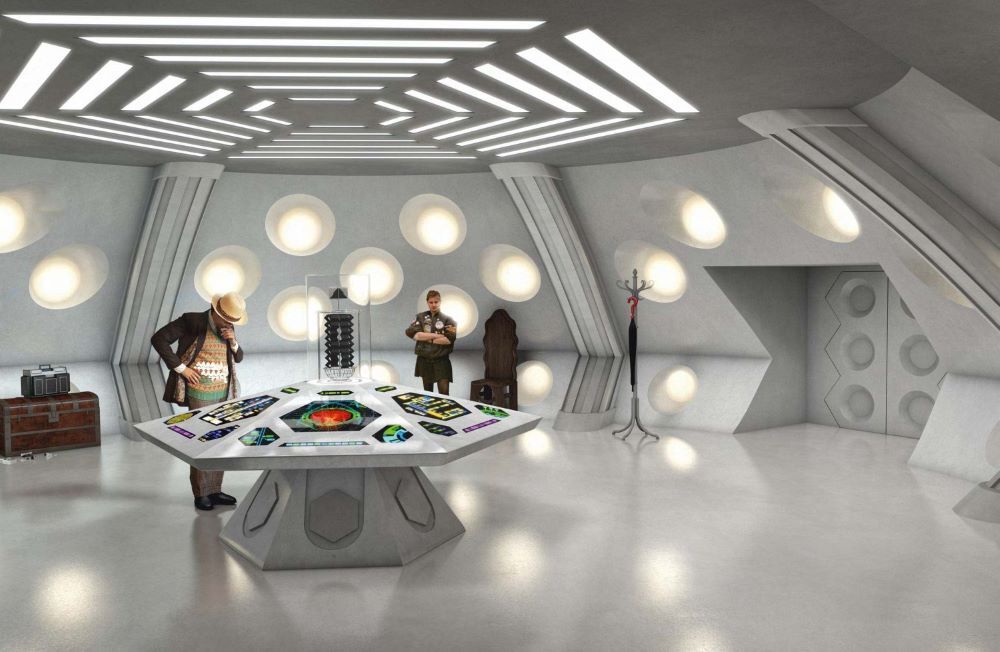
- The Eleventh Doctor's Titan comics TARDIS appears to be based on Rob Semenoff's 2002 fan concept, as updated in 2010.[1]
- The rotating wheels above the neon console are referred to as "time coordination wheels" in the audio description track of TV: Twice Upon a Time [+]Steven Moffat, Doctor Who Christmas Special 2017 (BBC One, 2017)..
- For DWM 532, Gavin Rymill designed a GC reconstruction of the TARDIS control room seen in Doctor Who Magazine stories starting with COMIC:The Chameleon Factor [+]Paul Cornell, DWM Comics (Marvel Comics, 1991).'.
Footnotes
- ↑ Rob Semenoff's website
| ||||||||||||||||||||||||||||||||||||||
